The week at a glance
- Black Scoter again in Aberdeenshire
- Yelkouan Shearwaters in Norfolk and Cornwall
- Sharp-tailed Sandpiper in Co Wexford
- House Crow still in Co Cork
- Probable Little Shearwater in Cornwall
- Possible Steppe Buzzard again in Suffolk
Autumn hotted up slightly this week, with a flush of new arrivals including a whole host of waders in Ireland and yet more notable seabirds. On the sea, the drake Black Scoter remained off Murcar and Blackdog (Aberdeenshire) to at least 28th, in the company of up to five Surf Scoters. The drake was also reported again off Bamburgh (Northumberland) on 29th–30th, but these reports appear to refer to a Common Scoter with an extensively yellow bill.
A very good shout was a Yelkouan Shearwater past a handful of lucky observers (including one BBRC member) at Cley (Norfolk) on 29th. Rather luckily it passed at close range allowing most of the salient features to be seen well, so it'll be interesting to see how this record fares with the committee. A second probable also flew past Pendeen (Cornwall) on 27th, though was more distant and brief. Cornwall also saw a probable Little Shearwater, past Porthgwarra on 28th, a day that also produced a single Great Shearwater.
An adult Sharp-tailed Sandpiper was an excellent find for a visiting group of Finnish birders at Shannon Airport Lagoon (Clare) on 26th–28th, representing the first record for the county. What was possibly a different bird, a very smart summer-plumaged adult, was then at Tacumshin (Wexford) on 29th–31st. This is actually the third record for the site, following previous adults in August 1994 and September 1997. Tacumshin's purple patch for waders continued, with a stellar cast of Pacific Golden Plover, two Semipalmated Sandpipers, two White-rumped Sandpipers, Baird's Sandpiper and Buff-breasted Sandpiper all recorded during the week! Also in Ireland, the House Crow remained in Cobh (Cork), reported on 29th.

Sharp-tailed Sandpiper, Tacumshin, Wexford (Photo: Paul Kelly)
Lastly, the possible Steppe Buzzard popped up again, seen over Tunstall Forest (Suffolk) on 30th. This bird was last reported at the end of June, so does it help or hinder its acceptance that it's still in residence two months later?
There were no Snow Geese to report, but there was a single Ross's Goose at Inner Marsh Farm (Cheshire) on 27th, though this is a presumed escapee. Other interesting escapes included two South African Shelducks at Wigg Island (Cheshire) on 28th and, drawing far more observers, a female Burrowing Owl in fields at East Runton (Norfolk) on 27th. The female Ruddy Shelduck was again at Abberton Reservoir (Essex) to 30th, along with up to 27 Spotted Redshanks; the only other Ruddy Shelduck reported was at Stainton (South Yorks) on 27th.
In Ireland, the drake Black Duck and one of its hybrid young was again reported from Achill Island (Mayo), though it's likely that these birds are as good as resident there. Also from the west, the eclipse drake Blue-winged Teal remained at Saltholme (Cleveland) to 29th and drake Ring-necked Ducks were at Wheldrake Ings (West Yorks) on 26th and Chew Valley Lake (Somerset) on 29th. There was just a single Ferruginous Duck reported, at Corfe Mullen (Dorset) on 30th. On the sea, apart from the drakes in Aberdeenshire, there was just one other Surf Scoter, another drake, in Lunan Bay (Angus & Dundee) again on 25th.
Although most seabird interest remained in the southwest and Ireland, the east coast produced a quality bird of its own in the form of a presumed Fea's Petrel north past Flamborough Head (East Yorks) on 31st. The eight accepted records of Fea's/Zino's Petrel from the headland are testimony to the efforts put in by seawatchers there. There was also another Fea's this week, past Seven Heads (Cork) on 25th. With 22 previous accepted records, Cork is by far the best place to catch up with this extreme vagrant, though convincing yourself of the specific identification isn't always going to be easy.
Once again, records of Cory's Shearwater were swamped by those of Great Shearwater. Apart from 32 past Seven Heads (Cork) on 25th, 15 off St Agnes (Scilly) on 25th and smaller numbers at other sites in Cork, most records of Cory's were singletons: off Brandon Point (Kerry), Plymouth (Devon), Porthgwarra (Cornwall), Spurn (East Yorks), Rubha Reidh (Highland) and St Aldhelm's Head (Dorset). Great Shearwaters were rather more widely reported, with reports from 11 sites in the southwest and Ireland. Most were single-figure counts, though the start of the week saw some excellent counts reported, including 126 past Seven Heads (Cork), 70 off the Scilly pelagic, 82 past St Agnes (Scilly), 54 past Cape Clear (Cork), 14 past Ballycotton (Cork) and 11 past Porthgwarra (Cornwall), all on 25th. Another notable seabird count was a massive 8,000 Sooty Shearwaters past Slyne Head (Galway) on 27th. The only Wilson's Storm-petrels reported were three off the Scilly pelagic on 25th.

Wilson's Storm-petrel, Scilly pelagic, Isles of Scilly (Photo: Joe Pender)
Apart from the regular birds at Dungeness (Kent), Meare Heath (Somerset) and around Blashford Lakes (Hants), the only Great White Egrets reported were south over Spurn (East Yorks) on 25th, at Leighton Moss (Lancs) on 25th–27th and at Restronguet Creek (Cornwall) on 31st. Dungeness also held onto its Cattle Egret all week, and one also remained at Thorney Island (West Sussex) all week, roosting with up to 123 Little Egrets, and the Essex adult was at West Canvey Marsh on 26th. There were then single records of Night Heron, at Weir Wood Reservoir (West Sussex) on 30th–31st, and White Stork, over Southampton (Hants) on 30th. Up to 14 Spoonbills remained at Cley Marshes (Norfolk), with other records spread widely along the south and east coasts between Dorset and Angus & Dundee. Away from Norfolk, the highest counts were five at Elmley Marshes (Kent) on 28th and Gibraltar Point (Lincs) on 29th.

Cattle Egret, Thorney Island, West Sussex (Photo: Juliet Moore)

Spoonbill, Cley Marshes NWT, Norfolk (Photo: Chris Upson)
in what may be the return of the recent Lincolnshire bird, a White-tailed Eagle was at Newbiggin-by-the-Sea (Northumberland) on 26th. The only Black Kites reported were the wandering Cornish bird, which moved to Lizard Point on 27th–29th, and one at Whaddon (Bucks) on 31st, although a probable was also over Hilbre Island (Cheshire) on 25th. Hot on the heels of the Fair Isle record, there were a remarkable three Pallid Harriers this week. On Shetland, a juvenile was at Norwick, Unst on 25th, with presumably the same at Bressay on 26th, Out Skerries on 27th and then Northdale, Unst on 28th–30th. A juvenile male was then on St Mary's (Scilly) on 29th–30th, just the third record for the islands, and a juvenile was at Tacumshin (Wexford) on 30th–31st, just the second record for Ireland following one in Cork and Antrim in April.

Pallid Harrier, Northdale, Unst, Shetland (Photo: Robbie Brookes)

Pallid Harrier, St. Mary's, Isles of Scilly (Photo: Martin Goodey)
The Spotted Crake remained at Meare Heath (Somerset) all week, showing well at times, and there was a further probable seen in flight at Bowling Green Marsh (Devon) on 30th. Various Pluvialis plovers were reported, including a probable American Golden Plover over Easington (East Yorks) on 26th and an American/Pacific Golden Plover at Newbiggin-by-the-Sea (Northumberland) for five minutes on 26th.
The adult Marsh Sandpiper remained at Grove Ferry (Kent) to 25th and the juvenile Wilson's Phalarope also remained at Belfast Lough (Antrim) to 26th. A migrant Red-necked Phalarope was on Brownsea Island (Dorset) on 26th and two were reported from Eyebrook Reservoir (Leics) on 30th. Another proved popular at Cley Marshes (Norfolk) on 26th–28th, but was somewhat overshadowed by the exceptional modern-day count of 41 Curlew Sandpipers. The only Grey Phalaropes were off Bridges of Ross (Clare) on 25th, Rumps Point (Cornwall) and Fife Ness on 27th, Baile Gharbhaidh, South Uist (Outer Hebrides) on 29th and at sea off Barra (Outer Hebrides) on 29th. An unexpected surprise was a Great Snipe on Fair Isle on 30th, the second on the island this year.

Grey Phalarope, Baile Gharbhaidh, S. Uist, Outer Hebrides (Photo: Steve Duffield)
Away from the wader magnet of Tacumshin, there was plenty of other wader interest. A juvenile Semipalmated Sandpiper was at Doughmore (Clare) on 26th–27th and another at Castlerock (Londonderry) on 28th–29th. The adult White-rumped Sandpiper was again at Blennerville (Kerry) on 29th, and two adults were at Rosslare (Wexford) on 27th; this side of the Irish Sea, one was at Hoylake (Cheshire) on 31st. A juvenile Baird's Sandpiper was on Hayle Estuary (Cornwall) on 30th–31st and another was at West Burra (Shetland) on 30th. The surprising lack of Pectoral Sandpipers continued, with a popular bird at Branston Gravel Pits (Staffs) on 27th–28th and others at Saltholme (Cleveland) on 29th, Truska (Galway) and Loch of Banks (Shetland) on 30th and Meare Heath (Somerset) and between Strumpshaw Fen and Cantley Beet Factory (Norfolk) on 31st, the latter with up to 80 Ruff. Temminck's Stint records came from just five sites: Idle Valley (Notts) on 25th–29th, Chew Valley Lake (Somerset) on 26th–27th, Pulborough Brooks (West Sussex) to 27th, Aberdeen on 28th and Farlington Marshes (Hants) on 31st.

Baird's Sandpiper, Hayle Estuary, Cornwall (Photo: Brian Mellow)

Pectoral Sandpiper, Branston GPs, Staffordshire (Photo: Alan Shaw)
Several sites recorded multiple Long-tailed Skuas, including five past Melmore Head (Donegal) on 28th, four past Hartlepool Headland (Cleveland) on 29th and three past Newbiggin-by-the-Sea (Northumberland) on 29th. The only Glaucous Gull was the resident bird at Dungeness (Kent), and there was just one Iceland Gull, at Tarbolton (Ayrshire) to at least 30th. There were three adult Ring-billed Gulls: at Black Rock Strand (Kerry) on 27th–29th, Stanpit Marsh (Dorset) on 28th and Kinneil Lagoon (Forth) on 30th. The adult Bonaparte's Gull remained at Seaburn (Durham) to 28th–31st, and two other adults from earlier in the year also reappeared, on Berneray (Outer Hebrides) on 25th–26th and at Dawlish Warren (Devon) on 29th–30th. There were still good numbers of Sabine's Gulls, with birds reported from all coasts, including possibly the same adult reported at various sites in East Yorkshire on 29th.
An exceptional 72 minutes at Rainham Marshes (London) on 26th involved a juvenile White-winged Black Tern seen heading upriver at 13:00 by observers on both sides of the river. Quite incredibly, this was followed at 14:12 by an adult Whiskered Tern, again heading upriver and seen by some of the same observers! Apart from one reported off Cross Ness in July 2010, this may well be the first record of the latter for the capital, although one at King George and Staines Reservoirs (Surrey) in May 2005 makes it onto the LNHS checklist.
The lone Bee-eater remained on St Mary's (Scilly) all week. The Hoopoe also remained on Coll (Argyll) to 26th, with others on Skokholm (Pembrokeshire) on 26th–29th and in a garden at Wells (Somerset) on 27th. With the wind continuing to blow in from the east, numbers of Wrynecks continued to increase: birds were at 26 sites across the country, including a cluster of inland birds at Ranmore Common (Surrey) on 27th, Wimbledon (London) on 29th and still at Alexandra Park (London) to 28th. Another inland bird was in Northampton on 31st. There were then two at Portland Bill (Dorset) on 29th, four on North Ronaldsay (Orkney) on 25th and five on Fair Isle on 25th, down from the belatedly reported 19 the previous day! The 25th on Fair Isle was one of those dreamed-of days, with migrant counts including seven Common Rosefinches, six Barred Warblers, 104 Tree Pipits, 20 Whinchats and a Red-backed Shrike. Another Tree Pipit count worthy of note was 70 over Durlston (Dorset) on 25th.
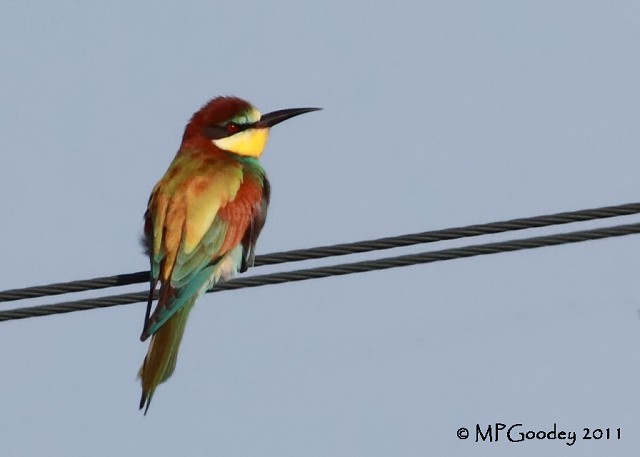
European Bee-eater, St. Mary's, Isles of Scilly (Photo: Martin Goodey)

Hoopoe, Coll, Argyll (Photo: Jo Scott)

Wryneck, Hook-with-Warsash LNR, Hampshire (Photo: Joe Stockwell)

Wryneck, Wells-next-the-Sea, Norfolk (Photo: Rob Wilson)
The only Short-toed Lark was also on Fair Isle, on 27th. There were three Citrine Wagtails: a smart first-winter was at Seaforth (Lancs) on 28th, only the second for the county following one in May 1997, another was at Boyton Marshes (Suffolk) also on 28th, and the third was on St Agnes (Scilly) again on 31st. Interestingly, the Seaforth bird was preceded by another probable on 26th, though this was a very poorly marked individual. There were also further probables at Rigifa Pool (Aberdeenshire) on 25th and Landguard (Suffolk) on 30th. Rather unusually, all the Red-backed Shrikes were concentrated in Norfolk and Shetland, birds at Winterton Dunes, Walsey Hills, Cley Marshes and Holme Dunes in the south and Quendale, Sumburgh and Fair Isle in the north. The only Woodchat Shrike was a juvenile on St Agnes, St Mary's and Tesco (Scilly) to 29th.

Citrine Wagtail, Seaforth LWT (Permit only), Lancashire (Photo: Gavin Thomas)

Red-backed Shrike, Walsey Hills NOA, Norfolk (Photo: Chris Upson)
Red-backed Shrike, Walsey Hills NOA, Norfolk (video: norfolkvidiscope)
What may well turn out to be the last Aquatic Warblers of the year were at Dawlish Warren (Devon) on 25th and Margate (Kent) on 30th. Both birds were elusive and couldn't be relocated after finding. There were just two reports of Marsh Warbler: one ringed at the Calf of Man (Isle of Man) on 26th and another on North Ronaldsay (Orkney) on 31st. Last week's Booted Warbler at Grutness (Shetland) remained to 26th, with others at Skaw, Unst (Shetland) to 28th and on Fair Isle on 26th. Observers looking to relocate the Fair Isle bird were lucky enough to find a Melodious Warbler. Other Melodious Warblers were reported from Bardsey Island (Gwynedd) on 26th, Prawle Point (Devon) to 29th and Portland (Dorset) and St Abb's Head (Borders) on 30th. Bardsey also did the Hippolais double with two Icterine Warblers there on 26th; the only other was at Quarff (Shetland) on 29th. Norfolk would never miss out on a flurry of rare warblers, and Cromer was the place to be this week: a Western Bonelli's Warbler was there on 26th–29th and a Greenish Warbler on 25th–27th.
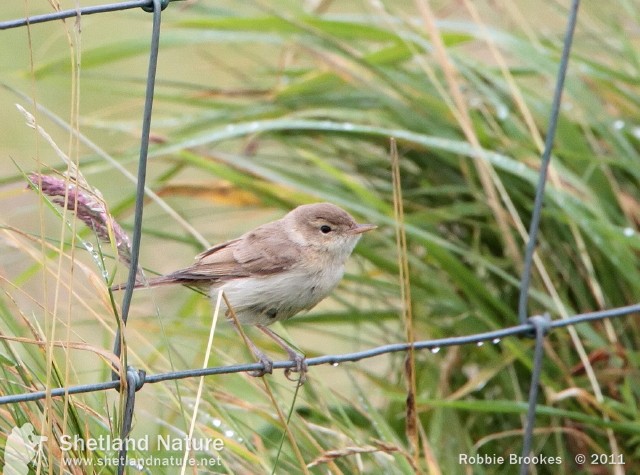
Booted Warbler, Skaw, Unst, Shetland (Photo: Robbie Brookes)

Melodious Warbler, Bardsey Island, Gwynedd (Photo: Richard Brown)
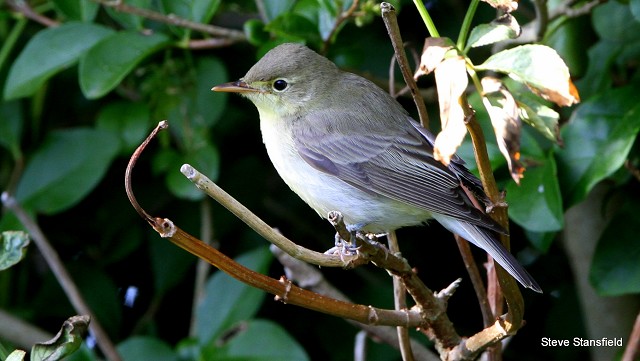
Icterine Warbler, Bardsey Island, Gwynedd (Photo: Steve Stansfield)
Other warbler highlights included Arctic Warblers at Valyie, Unst (Shetland) on 25th and Grutness (Shetland) to 26th and a good scattering of east-coast Greenish Warblers: at Thorpeness (Suffolk), Cromer (Norfolk), Flamborough Head (East Yorks), Whitburn Coastal Park (Durham), Collieston (Aberdeenshire) and Sumburgh and Wester Quarff (Shetland). Shetland was also the place to be for Barred Warblers; excellent numbers were reported from more than 10 sites across the islands, including at least seven on Fair Isle. Elsewhere, the only others were at Hawthorn Dene (Durham) on 25th, Balcomie (Fife) on 27th and in a private garden at Rhyd-y-clafdy (Gwynedd) on 29th.

Barred Warbler, Burravoe, Yell, Shetland (Photo: Dougie Preston)
The easterlies were perhaps also responsible for a small number of Serins in the southeast, including birds at Margate (Kent) on 27th, Grove Ferry (Kent) on 28th and Christchurch Harbour (Dorset) on 30th. Apart from the flock of Common Rosefinches on Fair Isle, numbering over nine this week, there were plenty of others in Shetland, including three at Quendale on 25th, three at Norwick, Unst on 28th–31st, two at Geosetter on 25th and two at Burrafirth, Unst on 26th. Further south, the only record was of one ringed at Spurn (East Yorks) on 31st. Lastly, the first Ortolan Bunting of the autumn was a first-winter on the golf course on St Mary's (Scilly) on 31st.

Ortolan Bunting, St. Mary's, Isles of Scilly (Photo: Martin Goodey)
Photo of the Week: 25th–31st August
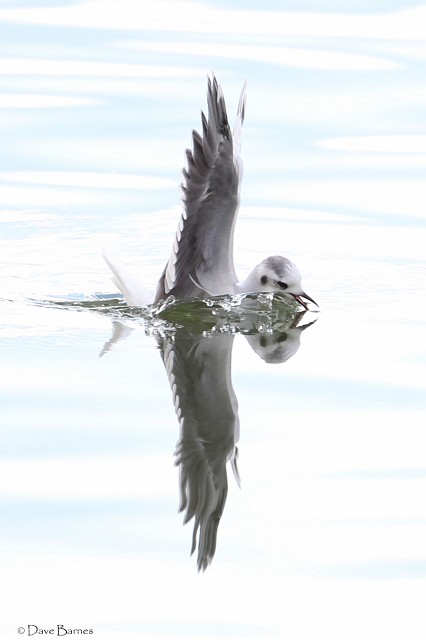
Little Gull, Gailey Reservoirs, Staffordshire (Photo: Dave Barnes)
Worcestershire-based bird photographer Dave Barnes has this week become the fifth photographer in only seven weeks to be awarded their first Photo of the Week. Interestingly, though, Dave's winning image shows the importance of keeping an eye out for unexpected photo opportunities whatever your photographic plans. The presence of a Red-necked Grebe at Gailey Reservoirs in Staffordshire over the last couple of weeks has seen a number of photographers head to this destination. Dave did manage to photograph this grebe but, as a bonus, also managed to hook up with an adult Little Gull that also happened to drop into this site. At this time of year, large numbers of these diminutive gulls — the world's smallest — can be found plucking insects from the surface of favoured lakes to build their energy reserves for migration. With a perfectly timed shot, Dave has captured the precise peak of this behavioural action, the bird's bill just snapping shut on its target as its body plunges into the water. To make this image even more striking, though, it has been processed as a high-key image, the outline of the bird and its clear reflection forming a graphic shape against the bright background of calm water. Dave's website profile explains how he turned to photography after failing to draw birds successfully. We're glad he did!

Barn Owl, undisclosed site, Guernsey (Photo: Chris Bale)

Sanderling, Minsmere RSPB, Suffolk (Photo: Jon Evans)

Great White Pelican, Kenya (Photo: Ian Williamson)

Wire-tailed Swallow, Thailand (Photo: Bam)

Spotted Redshank, Eden Estuary, Fife (Photo: John Anderson)

Dunlin, Landguard NR, Suffolk (Photo: Ian Clarke)
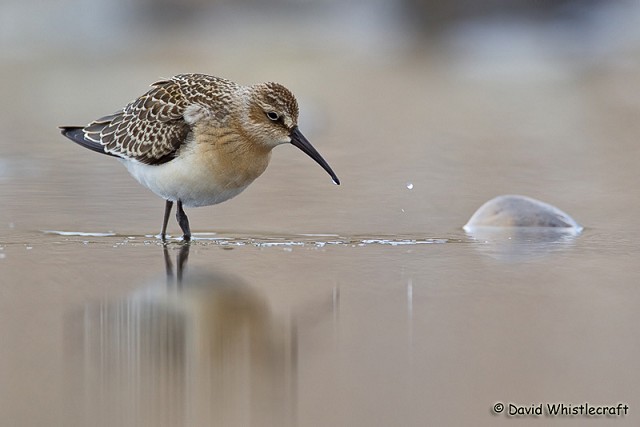
Curlew Sandpiper, Cley next the Sea, Norfolk (Photo: David Whistlecraft)

Rock Pipit, Campbeltown, Argyll (Photo: Jamie MacArthur)

Sand Martin, Blashford Lakes HWT, Hampshire (Photo: Sandra Palme)

Peregrine Falcon, Wick, Gloucestershire (Photo: Pete Blanchard)

Pallid Harrier, Northdale, Unst, Shetland (Photo: Robbie Brookes)
Photo of the Week: 18th–24th August

Sooty Shearwater, Scilly pelagic, Isles of Scilly (Photo: Joe Pender)
In the UK, August can be a pretty bleak time for birding in general. As always, though, it is possible to find great birds and great photo opportunities. One option is to book on a pelagic trip to catch up with an array of seabirds in their home environment. Over the last few weeks, Joe Pender has uploaded photos of a mouthwatering range of species, including Wilson's Storm-petrel, Sabines's Gull and at least four shearwater species. Clicking on Joe's website link reveals that he actually runs pelagic trips around the Scilly Isles and has done so for over 15 years. This may give him more bites at the cherry than most but, for any one seabird flypast, he faces the same challenges as his passengers in overcoming the erratic movements of bird and boat. He certainly succeeded with his latest image of a Sooty Shearwater banking inches above the waves. Pelagic images with such perfect pose and framing are few and far between, but to get one with such good lighting and detail is very rare. We're certainly impressed enough to award Joe his first Photo of the Week.

Little Owl, undisclosed site, Lancashire (Photo: Austin Thomas)

Knot, undisclosed site, Devon (Photo: Rob Cross)

Grey Heron, London Wetland Centre WWT, Greater London (Photo: Tom Hines)

Bar-tailed Godwit, Kingsbarns, Fife (Photo: John Anderson)

Spotted Redshank, Oare Marshes NR, Kent (Photo: Ian Curran)

Spotted Crake, North Cave Wetlands, East Yorkshire (Photo: Martin Standley)

Siskin, Bwlch Nant-yr-Arian, Ceredigion (Photo: Kev Joynes)

Green Woodpecker, undisclosed site, Cheshire (Photo: Richard Steel)

Sand Martin, Minsmere RSPB, Suffolk (Photo: Dave Martin)

Common Snipe, Cley Marshes NWT, Norfolk (Photo: Chris Cook)
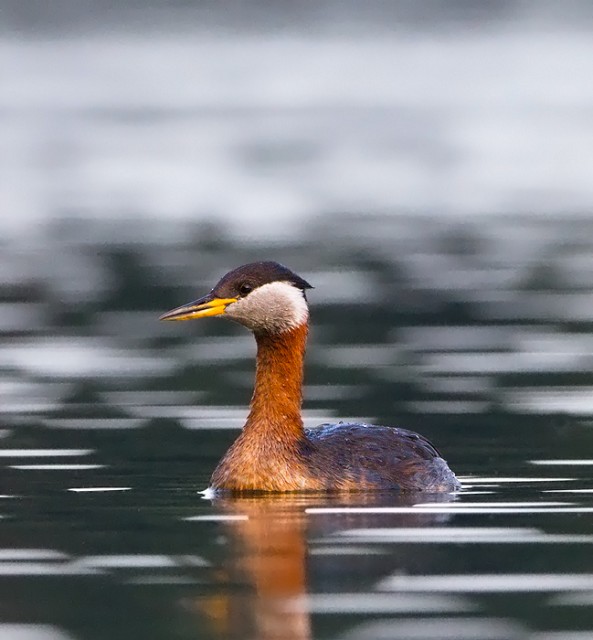
Red-necked Grebe, Gailey Reservoirs, Staffordshire (Photo: Carl Day)

Hoopoe, Coulsdon, Greater London (Photo: Phil Wallace)

Sabine's Gull, Staffin Bay, Skye, Highland (Photo: Nick Davies)

